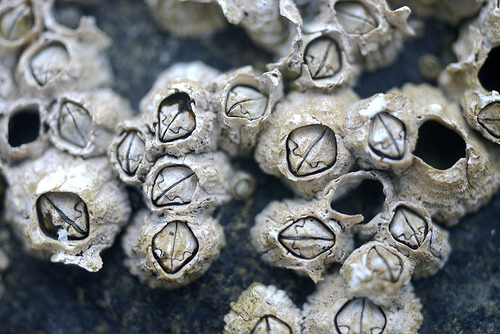Whatever you do, do not have a barney over barnacles!
- Barnacles are a group of over 1000 species of marine animal that have an exoskeleton and segmented body, and are typically found near or in saltwater of shallower depths.
- Barnacles are an infraclass that have the scientific name, Cirripedia, and are from the class Maxillopoda, a class of various crustaceans such as copepods.
- Barnacles live on a single sturdy object for its entire life of approximately 8 to 20 years, absorbing food such as plankton and algae from the surrounding water.
- Mussels and limpets are common neighbours of barnacles; and the three animals often battle for space on available surfaces.
- Barnacles are preyed on by many animals including fish and crabs during the larval phase as they have little protection, however, once they have settled and produced their outer shell, they are generally protected from most predators, but they are susceptible to whelks.
Barnacles
Image courtesy of Mo Riza/Flickr
- Barnacles live in a shell made of 6 plates, that are grown once the young permanently attaches onto a surface, and they are commonly found in groups as another form of protection against predators.
- Larvae of barnacles generally swim in the water for 6 months or more, until the animals find a permanent surface that they attach to via the head, using antennae and a glycoprotein based mixture.
- Some countries eat ‘goose’ barnacles from the order Pedunculata, in their culinary dishes, including Spain and Portugal of Europe.
- Barnacles are typically white, cream, black or yellow in colour, while shells are often a bleached white.
- Barnacles attach themselves to objects such as rocks, but also animals including turtles, whales and crabs, or buildings and boats, which can be both hard to remove and damaging to the object, and can cause significant speed loss in boats.
Bibliography:
Barnacle, 2013, A-Z Animals, http://a-z-animals.com/animals/barnacle/
Barnacle, 2014, Wikipedia, http://en.wikipedia.org/wiki/Barnacle







